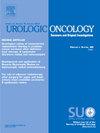年龄依赖性基因改变与肾细胞癌中不同的免疫谱相关。
IF 2.3
3区 医学
Q3 ONCOLOGY
Urologic Oncology-seminars and Original Investigations
Pub Date : 2025-08-05
DOI:10.1016/j.urolonc.2025.07.009
引用次数: 0
摘要
背景:遗传改变(GAs)在肾细胞癌(RCC)中随时间积累的作用尚不清楚。我们按年龄组检查了GAs及其与总生存期(OS)、免疫浸润和免疫检查点抑制剂(ICI)反应的关系。方法:分析来自AACR Project GENIE注册中心的3,360例RCC患者的下一代测序数据。频率为bb0 ~ 5%的GAs按年龄划分为75岁。Kaplan-Meier分析评估OS。使用TIMER2.0和ROC绘图仪评估免疫谱和ICI反应。还进行了共现和合成致死(SL)分析。P < 0.05被认为是显著的。结果:在3360例患者中,透明细胞癌占53.8%,乳头状癌占25.5%,憎色癌占12.1%。年轻和老年患者分别表现出较高的MUC4(13.9%)、TP53(9.6%)、VHL(48.4%)、TTN(21.0%)和PBRM1 (27.8%) GAs (P < 0.001)。亚型分析显示,透明细胞RCC在很大程度上驱动了这些模式。老年患者的嫌色性RCC显示KMT2C、MST1和MUC4明显升高,而乳头状肿瘤没有显示。TP53、VHL、TTN和PBRM1的改变与较差的OS相关(P < 0.001)。TP53、TTN和PBRM1也表现出不同的免疫特征,尽管ICI反应的差异不明显,可能是由于样本量小。鉴定出几个新的SL对。结论:RCC中年龄相关的GAs主要由透明细胞和憎色细胞亚型驱动。这些改变与生存和免疫谱的差异有关,但与ICI反应无关。本文章由计算机程序翻译,如有差异,请以英文原文为准。

Age-dependent gene alterations is associated with distinct immune profiles in renal cell carcinoma
Background
The role of genetic alterations (GAs) in renal cell carcinoma (RCC) accumulating over time remains unclear. We examined GAs by age group and their associations with overall survival (OS), immune infiltration, and immune checkpoint inhibitor (ICI) response.
Methods
Next-generation sequencing data from 3,360 RCC patients in the AACR Project GENIE registry were analyzed. GAs with >5% frequency were stratified by age into <45, 45 to 75, and >75 years. Kaplan-Meier analysis assessed OS. Immune profiles and ICI responses were evaluated using TIMER2.0 and ROC Plotter. Co-occurrence and synthetic lethality (SL) analyses were also performed. P < 0.05 was considered significant.
Results
Among 3,360 patients, 53.8% had clear cell, 25.5% papillary, and 12.1% chromophobe RCC. Younger and older patients exhibited significantly higher MUC4 (13.9%), TP53 (9.6%), and VHL (48.4%), TTN (21.0%), and PBRM1 (27.8%) GAs, respectively (P < 0.001). Subtype analysis revealed that clear cell RCC largely drove these patterns. While chromophobe RCC in older patients showed significantly higher KMT2C, MST1, and MUC4 alterations, papillary tumors showed none. TP53, VHL, TTN, and PBRM1 alterations were associated with worse OS (P < 0.001). TP53, TTN, and PBRM1 also showed distinct immune profiles, although differences in ICI response were not demonstrable, presumably due to small sample size. Several novel SL pairs were identified.
Conclusion
Age-related GAs in RCC are largely driven by clear cell and chromophobe subtypes. These alterations are associated with differences in survival and immune profiles but not with ICI response.
求助全文
通过发布文献求助,成功后即可免费获取论文全文。
去求助
来源期刊
CiteScore
4.80
自引率
3.70%
发文量
297
审稿时长
7.6 weeks
期刊介绍:
Urologic Oncology: Seminars and Original Investigations is the official journal of the Society of Urologic Oncology. The journal publishes practical, timely, and relevant clinical and basic science research articles which address any aspect of urologic oncology. Each issue comprises original research, news and topics, survey articles providing short commentaries on other important articles in the urologic oncology literature, and reviews including an in-depth Seminar examining a specific clinical dilemma. The journal periodically publishes supplement issues devoted to areas of current interest to the urologic oncology community. Articles published are of interest to researchers and the clinicians involved in the practice of urologic oncology including urologists, oncologists, and radiologists.

 求助内容:
求助内容: 应助结果提醒方式:
应助结果提醒方式:


